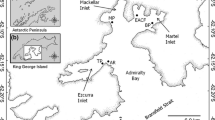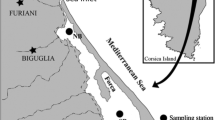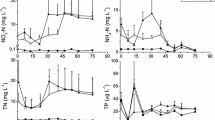Abstract
Over a 2-year program of monthly cruises covering the entire Chesapeake Bay (USA), the phytoplankters which passed 35 μm mesh were responsible for 89.6% of the phytoplankton productivity. On a single summer cruise, the <35 μm phytoplankton fraction was responsible for 93.4% of the chlorophyll a and 100% of the primary productivity. The <10 μm fraction was responsible for 81.3% of the chlorophyll a and 94% of the productivity. The difference in biomass in the <35 μm and the <10 μm fractions was significant (P=0.025), but no significant difference in the productivity could be demonstrated. Laboratory experiments demonstrated that recently assimilated carbon can be lost with gravity screening. Considering both this and the effect of herbivorous zooplankters enclosed in productivity incubations, a prescreening rather than postscreening technique is recommended for studying nanoplankton productivity.
Similar content being viewed by others
Literature Cited
Anderson, G. C.: Fractionation of phytoplankton communities off the Washington and Oregon coasts. Limnol. Oceanogr. 10, 477–480 (1965).
Carpenter, J. H.: The Chesapeake Bay Institute technique for the Winkler dissolved oxygen method. Limnol. Oceanogr. 10, 141–143 (1965).
—, D. W. Pritchard and R. C. Whaley: Observations of eutrophication and nutrient cycles in some coastal plain estuaries. In: Eutrophication: causes, consequences, correctives, pp 210–221. Washington: National Academy of Sciences 1969.
Cowles, R. P.: A biological study of the offshore waters of Chesapeake Bay. Bull. Bur. Fish., Wash. 46, 277–381 (1930).
Eppley, R. W.: Temperature and phytoplankton growth in the sea. Fish. Bull. U.S. 70, 1068–1085 (1972).
Findenegg, I.: Relationship between standing crop and primary productivity. In: Primary productivity in aquatic environments, pp 271–289. Ed. by C. R. Goldman. Berkeley: University of California Press 1965.
Flemer, D. A.: Primary production in the Chesapeake Bay. Chesapeake Sci. 11, 117–129 (1970).
— and J. Olmon: Daylight incubator estimates of primary production in the mouth of the Patuxent River, Maryland. Chesapeake Sci. 12, 105–110 (1971).
Gelin, C.: Primary production and chlorophyll a content of nanoplankton in a eutrophic lake. Oikos 22, 230–234 (1971).
Gilmartin, M.: The primary production of a British Columbia fjord. J. Fish. Res. Bd Can. 21, 505–538 (1964).
Holmes, R. W.: Surface chlorophyll-a, surface primary production, and zooplankton volumes in the Eastern Pacific Ocean. Rapp. P.-v. Réun. Cons. perm. int. Explor. Mer 144, 109–116 (1958).
— and G. C. Anderson: Size fractionation of C14 labeled natural phytoplankton communities. In: Symposium on marine microbiology, pp 241–250. Ed. by C. C. Oppenheimer. Springfield: C. C. Thomas 1963.
Holm-Hansen, O.: Determination of particulate organic nitrogen. Limnol. Oceanogr. 13, 175–178 (1968).
Kalff, J.: Phytoplankton abundance and primary production rates in two arctic ponds. Ecology 48, 558–565 (1967a).
—: Phytoplankton dynamics in an aretic lake. J. Fish. Res. Bd Can. 24, 1861–1871 (1967b).
—: Netplankton and nanoplankton production and biomass in a north temperate zone lake. Limnol. Oceanogr. 17, 712–720 (1972).
Loftus, M. E. and J. H. Carpenter: A fluorometric method for determining chlorophyll a, b, and c. J. mar. Res. 29, 319–338 (1971).
—, D. V. Subba Rao and H. H. Seliger: Growth and dissipation of phytoplankton in Chesapeake Bay. I. Response to a large pulse of rainfall. Chesapeake Sci. 13, 282–299 (1972).
Lohmann, H.: Neue Untersuchungen über den Reichtum des. Meeres an Plankton und über die Brauchbarkeit der verschiedenen Fangmethoden. Helgoländer wiss. Meeresunters. 7, 1–86 (1903).
Malone, T. C.: The relative importance of nanoplankton and netplankton as primary producers in the California Current System. Fish. Bull. U.S. 69, 799–820 (1971a).
—: The relative importance of netplankton and nannoplankton as primary producers in neritic and oceanic tropical waters. Limnol. Oceanogr. 16, 633–639 (1971b).
—: Diurnal rhythms in netplankton and nannoplankton assimilation ratios. Mar. Biol. 10, 285–289 (1971c).
Marshall, H. G.: Diurnal distribution of phytoplankton from a single station at the mouth of the James River. Ohio J. Sci. 66, 253–255 (1966a).
—: The distribution of phytoplankton along a 140 mile transect in the Chesapeake Bay. Va J. Sci. 17, 105–119 (1966b).
Patten, B. C., R. A. Mulford and J. E. Warinner: An annual phytoplankton cycle in the lower Chesapeake Bay. Chesapeake Sci. 4, 1–20 (1963).
Rodhe, W.: The primary production in lakes: some results and restrictions of the C14 method. Rapp. P.-v. Réun Cons. perm. int. Explor. Mer 144, 122–128 (1958).
—, R. A. Vollenweider and A. Nauwerck: The primary production and standing crop of phytoplankton. In: Perspectives in marine biology, pp 299–328. Ed. by A. A. Buzzati-Traverso. Berkeley: University of California Press 1958.
Saijo, Y. and K. Takesue: Further studies on the size distribution of photosynthesizing phytoplankton in the Indian Ocean. J. oceanogr. Soc. Japan 20, 264–271 (1965).
Schiemer, E. W. and D. W. Pritchard: An induction conductivity temperature indicator. Tech. Rep. Chesapeake Bay Inst. 25 (Ref. 61-4), 1–75 (1961).
Steemann-Nielsen, E.: The use of radioactive carbon (C14) for measuring organic production in the sea. J. Cons. perm. int. Explor. Mer 18, 117–140 (1952).
— and E. A. Jensen: Primary oceanic production. The autotrophic production of organic matter in the ocean. Galathea Rep. 1, 49–136 (1957).
Strickland, J. D. H.: Production of organic matter in the primary stages of the marine food chain. In: Chemical oceanography, Vol. 1. pp 477–610. Ed. by J. P. Riley and G. Skirrow. New York: Academic Press 1965.
Tate, M. W. and R. C. Clelland: Nonparametric and shortcut statistics in the social, biological, and medical sciences, 171 pp. Danville, Illinois: Interstate 1957.
Taylor, W. R.: Inorganic nutrient requirements for marine phytoplankton organisms. Occ. Publs Narragansett mar. Lab., Univ. Rhode Isl. 2, 17–24 (1964).
Teixeira, C.: Relative rates of photosynthesis and standing stock of net phytoplankton and nanoplankton. Bolm Inst. Oceanogr., S Paulo 13, 53–60 (1963).
Thomas, J. P.: Release of dissolved organic matter from natural populations of marine phytoplankton. Mar. Biol. 11, 311–323 (1971).
Watt, W. D.: Measuring the primary production rates of individual phytoplankton species in natural mixed populations. Deep Sea Res. 18, 329–339 (1971).
Whaley, R. C., J. H. Carpenter and R. L. Baker: Nutrient data summary 1964, 1965, 1966: Upper Chesapeake Bay (Smith Point to Turkey Point), Potomac, South, Severn, Magothy, Back, Chester, and Miles Rivers, and Eastern Bay. Spec. Rep. Chesapeake Bay Inst. 12 (Ref. 66-4), 1–77 (1966).
Williams, P. J. LeB., T. Berman and O. Holm-Hansen: Potential sources of error in the measurement of low rates of planktonic photosynthesis and excretion. Nature New Biol. 236, 91–92 (1972).
Wolfe, J. J., B. Cunningham, N. F. Wilkerson and J. T. Barnes: An investigation of the microplankton of Chesapeake Bay. J. Elisha Mitchell scient. Soc. 42, 25–54 (1926).
Yentsch, C. A. and J. H. Ryther: Relative significance of the net plankton and nannoplankton in the waters of Vineyard Sound. J. Cons. perm. int. Explor. Mer 24, 231–238 (1959).
Author information
Authors and Affiliations
Additional information
Communicated by J. Bunt, Miami
Rights and permissions
About this article
Cite this article
McCarthy, J.J., Rowland Taylor, W. & Loftus, M.E. Significance of nanoplankton in the Chesapeake Bay estuary and problems associated with the measurement of nanoplankton productivity. Marine Biology 24, 7–16 (1974). https://doi.org/10.1007/BF00402842
Accepted:
Issue Date:
DOI: https://doi.org/10.1007/BF00402842




